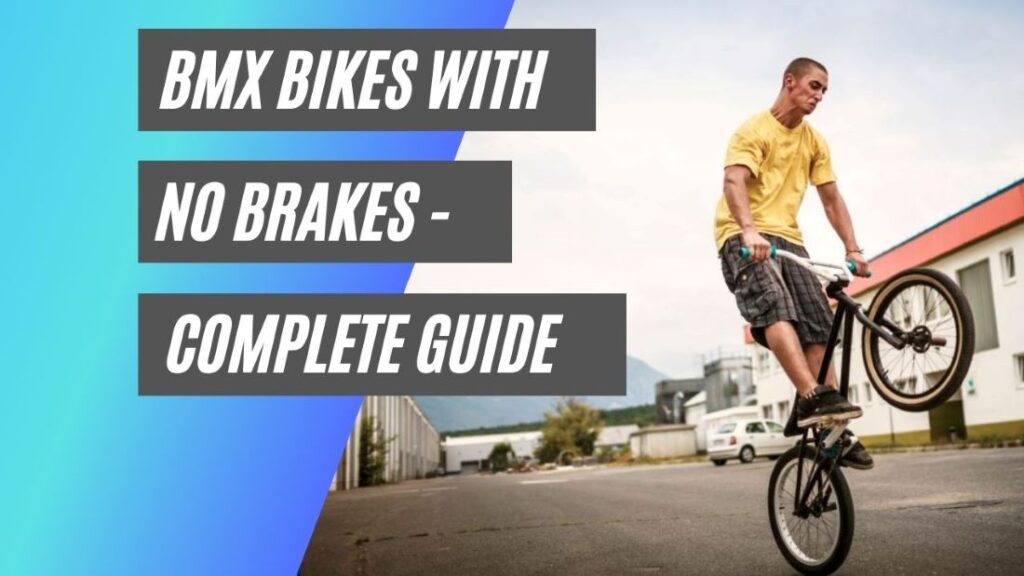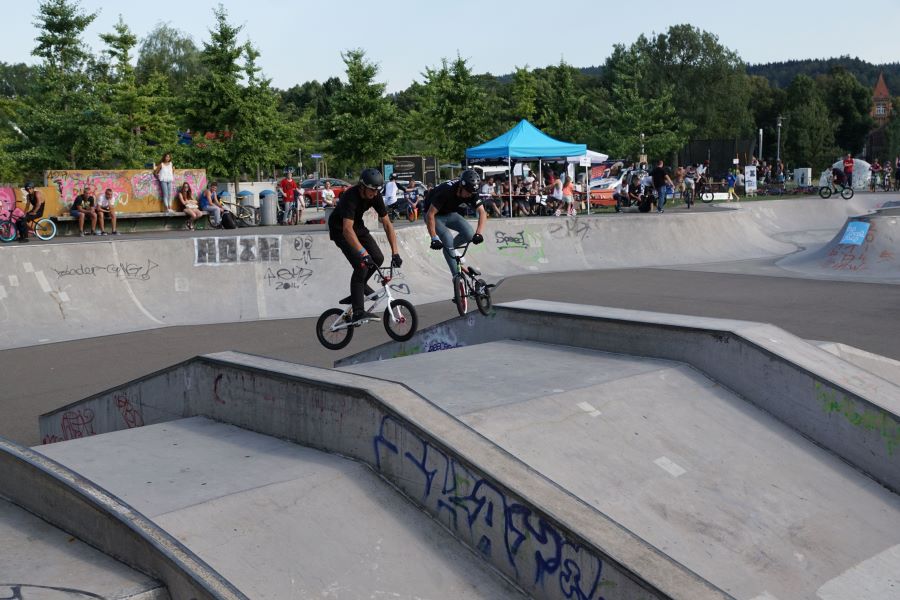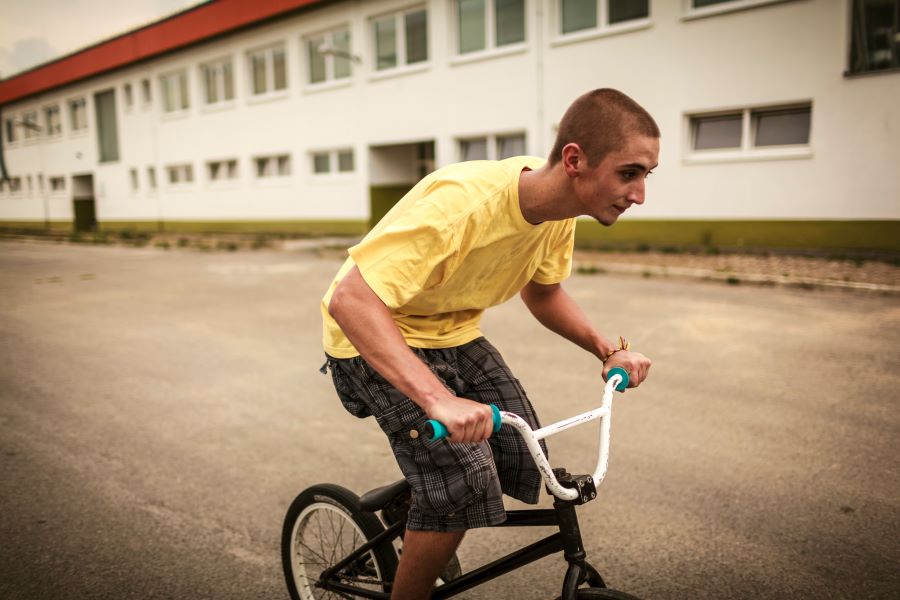This post may contain affiliate links. If you click an affiliate link and make a purchase, I may earn a commission. Also, as an Amazon Associate, I earn from qualifying purchases.--
Many types of BMXs do not have brakes, and there are many reasons for this.
Most riders looking to use their bike for freestyling or tricks now opt for a BMX without brakes. Since brake cables often get tangled with twisting handlebars, these bikes are used to make tricks more achievable.
I’ll be discussing:
- BMX bikes with no brakes – everything you need to know
- What BMX bikes with no brakes are used for
- Why you might want to buy them a BMX bike with no brakes

BMX Bikes Without Brakes
Over the years, brakeless BMX bikes have become somewhat of a trend.
The primary reason is that brakeless bikes tend to promote the ability to do tricks. This is a crucial aspect for many riders when choosing a BMX.
With no brakes, cyclists could throw numerous bar spins or tailwhip tricks without being restricted by the brake cable limit.
Plus, brakeless bikes also mean fewer parts to repair. So, on failed stunts, you’d spend less time and money fixing broken bike parts.
In general, riders go brakeless for better control over bikes, boosting an individual’s ability to do tricks.
As Boyd Hilder, a professional BMX rider, even said, “I prefer riding no brakes as the lever gets in my way when I pass the bars and don’t want to slow down.”
Overall, BMX riders take these factors into serious consideration when choosing brake setups. I like to believe less maintenance is always better. Due to its popularity and the need to describe its aesthetic, this brakeless bike style has also been defined as “new school” style cycles.
From a personal perspective, I think unwinding handlebars and frames after a couple tricks can be pretty troublesome.
So, having a brake-free look is simply a lot less messy. And, you wouldn’t have to waste any time changing or fixing brakes in between tricks, resulting in a smooth performance.

Brakeless BMX Bike Styles
As I brushed upon earlier, BMX bikes are often designed with numerous intentions in mind like any other bike. These can include various characteristic features that define specific riding styles and conditions.
The following are BMX styles that adopt the no brakes philosophy, with details on each.
Vert
A Vert is a kind of double-sided ramp or halfpipe that has been used by BMX riders and skateboards for tricks and stunts.
Though BMX ramps are more popular now, the name is more of a homage to a time when riders used the insides of empty pools to get air from escaping off the edges.
These half-pipes can vary in length and height. And, often, you can find Vert BMX bikes used at major sporting events like the X-games and other professional competitions that exceed the 8-meter mark.
The rider would go back and forth on each side of the ramp, launching themselves into the air with each oscillation. At this point, they would typically perform a number of stunts, such as flips, twists, spins, or something similar.
Likewise, the rider may grind along with the metal on the edges, with extension boxes reaching the top of the vert too.
By general standard, Vert BMX bikes can also be considered freestyle bikes. And, with a few tweaks and modifications, they could become any rider’s ideal bike. Not to mention, they tend to use really durable and smooth tires.
Freestyle
Like vert bicycles, freestyle BMX bikes can also be utilized for street courses and skatepark-style halfpipes. The term “freestyle” encompasses various distinct riding styles, with the bike made to focus on each aspect through slight tweaking.
Though it isn’t as speed-oriented as most other bikes, freestyle riding can be ideal for stunts or airs (rather than for races or handling jumps in a course).
Park
Despite being called Park BMX bikes, these cycles are more often used for a standardized form of street riding.
In this case, “park” refers to skate or bike park courses, which have setups for quarter pipes, ramps, rails, bowls, boxes, and possibly halfpipes and stairs.
They can implement wood and cement features, functioning as a street freestyle BMX bike. They could also contain thick frames, smooth tires, smaller cranks and cassettes, and double brakes.
In contrast, they would also be heavier than race BMX bikes; their build needs to be durable for potential accidents or falls at the park.
Though some variants of park BMX bikes may have full-brake setups, it isn’t necessary. These bikes would instead have pegs as a recurring feature.
These can be found on the front and rear wheel hub, enabling the rider to perform stalls, grinds, and possibly stand on them for some tricks.
Not to mention, the gear ratio on these bikes can be somewhat quirky. In essence, they make it easier to pedal from a complete stop, emphasizing short burst energies.
This is easier to manage on the track than bikes that maintain sustained speeds during a race.
Street
In general, street riding style is just freestyle bicycling that takes place on the streets of urban areas. It can incorporate rails, stairs, walls, ledges, and anything else the rider can utilize for their stunts and tricks.
Since its primary terrain is pavement, these bikes tend to have smoother tires for fluid traction and speed. And, to deal with potential impacts, their frames might also be heftier for extra reinforcement. Though most street bikes have a rear and front brake, they can also be brakeless for accessibility.
Dirt/Jumping
These bikes are made to handle the size and oscillation of jumps on a dirt track.
This includes the ability to withstand multiple jumps or maybe just one ‘big air’ jump. And, the riding style can somewhat be considered an adaptation of freestyle riding.
This is seen through the dirt jumping events these bikes are designed for; they basically consist of a series of stunts and tricks scored by judges.
These bikes also somewhat bridge the gap between racing bikes and freestyle. You can get the jump-oriented nature of a freestyle bike while considering speed last. Combined with its lightweight design, you get tires with more grip and tread on loose gravel and dirt.
Overall, these BMX bikes are ideal for maneuvering across dirt, getting bigger airs, and bearing through brutal landings.

If Brakes Aren’t Preferred, Why Do BMX Bikes Still Have Them?
Considering the numerous benefits of brakeless bikes, it’s worth asking why do BMX bikes still have them.
Well, for starters, BMX bikes have to be sold with some structure. In most nations, riding brakeless bikes could be considered an unlawful act.
The UK, USA, and other European nations often fine BMX riders for riding on open streets without brakes.
This is because, according to transit regulations, cyclists should be able to stop during crisis circumstances. Without breaks, riders would be responsible for any unfortunate mishaps.
Likewise, though US laws fluctuate from state to state, many areas require bikes with brakes for street use. They specify that these breaks need to stop at least one wheel on dry and level asphalt.
So, as a safety consideration, these bikes have been developed to stop rapidly to avoid crashing or potential accidents.
Especially on open streets, where automobiles of all kinds and sizes drive by, riders need to take care of themselves and others they may impact. They need to think of well-being as a primary concern. Cyclists need to think about their sport and the effect cycling on open roads could have on others.
However, with that being said, free-form BMX riders don’t need to abide by street laws. Shifting their focus to primarily sidewalks and skate parks, these cyclists can feel free without any consequences.
In their case, the straightforwardness of brakeless bikes provides them with better opportunities to perform complex procedures and tricks; they would need to loosen their brake links to partake in any stunts.
Is it illegal?
As stated earlier, some laws forbid riders from using brakeless bikes on public roads. But, this doesn’t necessarily entail a ticket, as it’s often not considered a huge offense.
In general, to comply with regulations, most (if not all) BMX bikes need to be sold with at least one break.
So, if you remove brakes from your bikes, you would only be legally allowed to ride that bike off-road.
If they don’t have brakes, how do they stop?
Since free-form BMX riders are restricted to parks, they don’t really reach the high speeds of an average BMX rider.
Instead, their bikes emphasize more estimated and controlled speed; this encourages smoother tricks and deceives.
On average, you would expect a typical free-form BMX stunt resulting in speeds of about 10 to 15 km/h. In contrast, while on an open road, a BMX bike could reach about 57 km/h if needed.
As a result, free-form cyclists can simply utilize their feet as brakes. Often, they just plant their feet on the back tire to hinder speed.
Likewise, another technique is also to jam the sole of your shoe into the rear wheel while resting it on the top of the frames near the triangle. Others may even use their toes in the front, but this is much more dangerous and could result in a more abrupt stop.
In any case, these techniques should ease riders into slower speeds, without injuring their feet. Though these strategies would not be recommended for an open street with traffic, they are ideal for the protected climate of skate or road parks.
What kind of brakes would they have?
Well, BMX bikes have two kinds of brakes: U-brakes and V-brakes. They can both be controlled by the hand switch mounted on the handlebar. And, most BMX bikes would have at least one rear brake, with only a few having front brakes too.
Depending on the kind of BMX bikes, these brakes can differ. For example, BMX racing bikes are often fitted with straight or V-brakes on their back edges.
And, in general, they tend to be lighter and more resourceful than U-brakes. To be more specific, U-brakes lack the definite stopping power of linear brakes. However, instead, they provide better control and leeway.
You will also occasionally find BMX bikes with other types of brakes. Here is a table that demonstrates the type of brakes you may find on a BMX, and the pros and cons of this type of brake:
| Type Of Brake | Popularity on BMXs | Pros | Cons |
| Cantilever | Less popular | High quality braking system | Require maintenance and proper set up |
| V-Bike Brakes | Very popular | Lightweight and good braking | Can collide with rider’s clothes or body |
| U-Brakes | Very popular | Most popular BMX brake | |
| Gyro Or Rotar | Medium popularity | Ideal for tangle-free freestyling | Higher maintenance required |
| Coaster | Popular on kids bikes | Low maintenance required | Make freestyling difficult |
| Caliper | Less popular | Generally a solid brake | Don’t work well on wider tires |
| Mechanical Disc Brakes | Less popular | Highly efficient modern braking system | Not suitable for every type of BMX |
BMX Bikes Today – The Technology
Today, BMX bikes have become so much more than just an adolescent desire.
With BMX racing being UCI (Union Cycliste Internationale) sanctioned and even featured in the Olympics, professional BMX rides are supported by teams and large-scale sponsors.
And through these changes and advances, BMXs now have numerous forms. The brakes have developed alongside this.
At their core, most BMXs are still used as off-road bikes made for racing and stunt riding. BMXs have always incorporated freestyle and street riding styles, with many adopting both.
BMX bikes are used for many different terrains.
Because of this, many bikes often look similar with only a few differences. Some might be smaller or stockier, but they always have a simple frame setup with thick tires for traction and shock. On a similar note, it’s rare to find multiple gears on a BMX bike, and brakes are only for particular types.
Summing Up
At the end of the day, if you’re looking to use your BMX primarily for stunts and tricks, then a brakeless model is probably the way to go.
However, if you’re looking to use it on a public road, then something with brakes is preferable.
Either way, BMXs offer a huge amount of versatility and joy in the act of riding.
